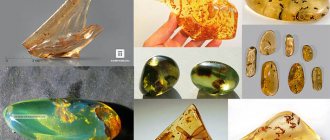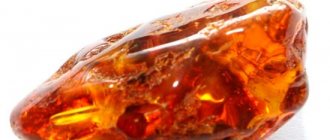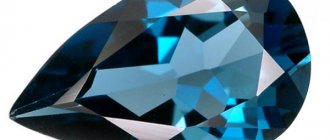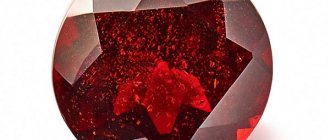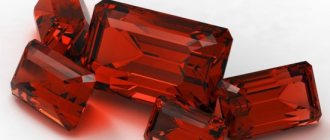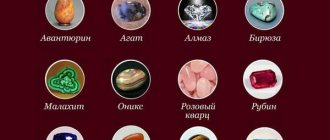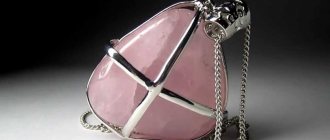Natural minerals have always been the subject of fascination. They were used to make jewelry, interior items, and designer items. They lined clothes and shoes, believing in the magical and healing properties of gems. One of the precious crystals is moonstone. It stands out for its iridescent shine and unique beauty. The gem looks great in a white frame and can complement any look. The value of moonstone has led to the spread of counterfeits. Unscrupulous sellers try to pass off an artificial nugget as an original sample. Such stones are found both in markets and in certified stores. Nowadays it is very common to find fake moonstones made of plastic or glass. It is impossible for an inexperienced person to visually distinguish a piece of glass from a natural gem. To avoid becoming a victim of fraud, you need to know how to distinguish a real mineral from a fake.
Technical properties
The main feature of this gem is the bluish-silver shimmer that moves within the crystal as you change your viewing angle.
Look how the soft glow of the stone looks in the photo: adularia fascinates with its beauty:
This phenomenon is called “adularescence” and is due to the fact that moonstone consists of very thin plates or layers that scatter light differently.
You can view the technical characteristics of the mineral in the table:
| Chemical formula | KAlSi3O8 |
| Density | 2,55-2,63 |
| Hardness | 6-6,5 |
| Dispersion | 0,012 |
| Refractive index | 1,519-1,525 |
| Color | colorless, white |
| Transparency | translucent, opaque |
| singonia | monoclinic |
| Kink | uneven, stepped |
| Cleavage | perfect |
| Pleochroism | absent |
| Fragility | fragile |
| Shine | glass |
One of the disadvantages of the mineral is its low hardness. It is processed with care and is more often used in pendants or pendants than in rings. A silver frame is chosen for the adularia: it should be solid, without “legs”. This fastening helps to avoid cracks or chips on the edges of the crystal.
If a piece of moonstone jewelry has been passed down through generations and has been worn carelessly or frequently, the adularia may need to be polished or re-polished. This will restore its lost shine and eliminate shallow scratches.
The stone is also affected by temperature and humidity. Under prolonged exposure to a contrasting environment, the shade of the mineral may change slightly. This phenomenon can be explained by the microporous structure of the crystal, but this property of the rare moonstone became the basis for the emergence of many legends and beliefs.
Appearance
The word "adular" comes from Adul, the name of the highest mountain peak in the Swiss Alps, also known as Rheinwaldhorn. Mineral deposits were found in this area for the first time.
The crystal received the name “moonstone” because of its amazing color and soft glow, which resembles a night star. There is a legend that, after lying for thousands of years on the surface of the earth and absorbing moonlight, the stone becomes adularia. In fact, crystals are formed in the earth's crust at a temperature of 660-700 ° C from silicate melts and hot aqueous solutions with a high concentration of potassium and silica.
Today, the highest quality minerals are mined in Sri Lanka. Commercial quality gems come from Australia, Brazil, India, Madagascar, Myanmar, Tanzania and the USA (Pennsylvania, Virginia). There are deposits of adularia in Russia: crystals are mined in the Urals and Siberia.
In the 17th-18th centuries, simple technologies for polishing the mineral were used, but what the processed moonstone looks like directly depends on its composition. The transparency of adularia and color inclusions determine the presence of additional substances and their proportionality. But all crystals, without exception, have a characteristic layering.
Similar stones
Confusion in the classification of moonstone arose due to the fact that for a long time it was used to call those types of feldspar that are characterized by iridization - an iridescent glow on the chip under very bright lighting.
The following similar types of minerals are often mistaken for moonstones:
- Selenite.
- Labrador.
- Belomorit.
In the first case, the crystals are similar to adularia in their transparency and the nature of light reflection. In addition, translated from Greek, the name of the mineral sounds like “Stone of Selene,” who in Ancient Hellas was the goddess of the Moon. But selenite is part of the gypsum group, so it should not be associated with adularia.
Labradorite is a plasioclase, but has different types of iridization that resemble the radiance of adularia. The most similar minerals are those with dark blue and blue iridescence, but among the characteristics of real moonstone there is only light blue iridization.
Belomorite is an incredibly beautiful mineral, which, like adularia, belongs to the group of feldspars. But its composition differs from classic moonstone. This affects the characteristics of belomorite: it has fascinating tints - from gray to violet-blue highlights. This mineral is very fragile, easily crumbles and delaminates, so large crystals are rarely found in jewelry. The main deposits of belomorite are located in North Karelia, as well as on the Kola Peninsula.
There are terms used to call adularia depending on its origin and characteristics. For example, valencianite is a type of natural moonstone mined in Mexico. These minerals are of high quality and are used for designer jewelry.
Aglaurite is an adularia with a characteristic blue glow, deposits of which are located in the east of the Czech Republic. Its name translated from Greek means “decoration”.
One of the rare crystals is adularia with a yellowish tint. The common people call it the “witch’s stone” and believe that such a mineral contains witchcraft powers. According to legend, during the full moon it takes on a reddish tint.
Take a look at the photos of varieties of unusual moonstone to appreciate their beauty:
What is adularia
Moonstone is a transparent, silver-gray or milky color mineral, distinguished from others by shimmering blue or white tints. Refers to semi-precious stones.
Moonstone looks like moonlight, which is why it got its name. Other names of the gem that can be found:
- fish eye;
- aglaurite;
- adularia;
- pearlspar;
- jandarakand.
Adularia, or moonstone, belongs to the group of potassium feldspars. Capable of iridescence (adularization) - internal glow. Thin stepped plates (lamellae) of albite, growing in the thickness of the mineral, cause its flickering.
Blue and golden tints arise due to interference - the refraction of light reflected from albite. If the plates are small, the glow effect will be similar to a cat's eye.
Varieties of Moonstone
Natural moonstone refers to varieties of quartz. There are many classification options; experts cannot come to a consensus. Main types:
- Belomorite - named after the place of extraction (White Sea). It has a matte snow-white or milky white color with a bluish tint, translucent.
- Adularia is a transparent or translucent yellow mineral, a type of orthoclase. Rare view. The most valuable is with a bluish tint.
- Sanidine is a blue moonstone with a three-dimensional iridescence.
- Labradorite is a black crystal found on the island of the same name.
- Amazonite is a green gem, a type of microcline.
The gem has different shades:
- white (from bright to milky);
- pink (from peach to lilac);
- yellowish;
- green;
- black;
- light gray with a blue tint.
The most valuable are gems with the effects of a cat's eye and starry sky, and rainbow tints.
For more information about some varieties of moonstone, see the review:
How to distinguish from a fake
The beautiful appearance of adularia and legends about its unusual properties attract buyers. Therefore, very often you can find a fake of this crystal. Amazonite, labradorite, and other types of feldspar, including belomorite, can be sold as moonstone.
The fake is made from frosted glass, which has a low cost. But such an imitation only vaguely resembles the original and is easy to identify.
There are several simple ways to distinguish a real moonstone from a synthetic fake. The adularia may have small defects inside: chips or cracks. The imitation is always a little brighter than the original, it has a pronounced shine. You can identify a glass fake by holding it in your warm palm. Adularia heats up slowly, because it is a fairly cold mineral.
Moonstone has layers, each of which reflects light differently. If you look at the crystal at the right angle, you will not be able to see the blue tint. Reflections (color shifts) appear only at a slope of 12-15˚С. Glass imitation of the mineral has a uniform shine that does not change depending on the angle of light reflection.
Look at the photo to see what the glow of a natural moonstone looks like: this property cannot be recreated artificially:
There is a technology for creating a mineral from low-quality crumbs of oligoclase and adularia. It is pressed, which makes it possible to obtain crystals with smooth color transitions. They can be semi- and completely transparent, matte or have slight cloudiness inside. But they can also be distinguished by their non-layered structure and the absence of bluish highlights.
On the market you can find an imitation of adularia, created from albite with the addition of benzene. In this fake natural moonstone, reflections appear only on the surface.
Sometimes there is synthetic spinel or chalcedony, which is sold as real adularia. They have only one layer and high hardness.
Synthetic (fake) moon rocks are not produced in batches. If, under the guise of moonstone, they offer to buy one of the minerals with similar iridization, it is easy to identify it by the absence of characteristic layering and light reflection, bluish highlights.
When choosing adularia, you cannot rely on its price: for an original and a high-quality fake of a natural moonstone, it may differ slightly, although the cost of artificial material is tens of times lower. Similar minerals that are sold as natural adularia are also inferior in price. Their inflated cost allows you to hide this difference and make a profit.
It is better to purchase adularia in a specialized jewelry store. The stone will have accompanying documents that indicate the type of mineral and additional information about the crystal.
Reasons for frequent counterfeits
There are several factors why adularia is so often counterfeited:
- The reserves of the gem began to deplete.
- Extraction requires large physical and material costs.
- There is high demand for products made from this magical crystal.
- High price of natural stones.
- Processing adularia requires painstaking work and professional skills.
The appearance of the fakes is almost no different from the original, but such an instance will not bring healing help.
average cost
The price of an adularia is influenced by its size: if it does not exceed 1 carat, the average cost of a natural moonstone can range from $1 to $30. In addition, the shade and transparency of the mineral matters.
Adularias of rare blue shades are highly valued: when light is reflected, the crystal appears “depth”. As it rotates, a unique three-dimensional effect is visible that minerals of other colors do not have.
Adularia of the highest quality have a colorless base. The best crystal combines glassy clarity with an electric blue tint. The main feature of adularia of the highest quality is its bright blue shine, visible from all sides. The price of such a moonstone can vary from $80 to $200 per carat with a weight not exceeding 20 carats.
Multicolor minerals that are mined in India are low cost. You can also buy adularia crumbs cheaply: original beads are often made from it.
In most cases, stones are cut into cabochons: this shape allows you to see the amazing bluish highlights inside the crystal and its layering. But for this you need large specimens of adularia, the price of which is quite high.
How much a natural moonstone costs often depends on its setting: designer framing with high-quality precious metal increases the price of the product. Adularias are usually set in silver, which is also associated with the Moon and beautifully highlights the highlights inside the cabochon. But sometimes gold is used for yellowish-colored minerals.
In jewelry, milky-white crystals can “neighbor” pearls: both minerals have delicate “lunar” shades.
High-quality large adularia are rare, so the price of jewelry made from natural moonstone is constantly growing.
Moonstone became popular among jewelers between 1890 and 1910, during the heyday of the Art Nouveau style, mainly thanks to two famous jewelers - Rene Lalique and Louis Comfort Tiffany. Adularia returned to fashion twice more: in the 60s and also in the 90s of the last century. Currently, this mineral is outside the jewelry mainstream and few well-known jewelry houses use it in their jewelry.
Look at the photo of jewelry with moonstone: they are very feminine and sophisticated:
If a woman or girl wears jewelry with adularia, she should take care of its harmonious combination with other elements of the image. The crystal is so distinctive that in combination with other jewelry it will look unnatural. An exception may be simple pearl items or silver items without inserts. It is worth focusing on the magical beauty and sophistication of moonstone. If it is a pendant, the garment should have an elegant contrasting shade that goes well with the color of the crystal.
Colors and varieties
Mineralogists classify several minerals as moonstone:
- Adularia is the most popular and valuable type among jewelers. May be colorless or translucent. It has a beautiful bluish or bluish glow.
Moonstone Adularia
- Belomorite is a milky-white translucent gem with a bright blue tint. It got its name from the place where it was first found - the coast of the White Sea.
Moonstone Belomorite
- Labradorite (“black moonstone”) - in reality it is not completely black, but has blue and bluish zones, which makes it even more mysterious. Named after the place where it was first discovered - in honor of the Canadian peninsula of the same name. The special iridescence of Labradorite contributed to the separation of this phenomenon into “labradorization” - the discarding of multi-colored tints and flashes when the viewing angle and lighting change.
Moonstone Labradorite
- Sanidine is a transparent stone. May have a gray, greenish or yellow tint. Indian multi-color samples are not highly valued and are cheap. In nature there are rare blue specimens with a multifaceted play of light; their cost is quite high.
Moonstone Sanidin
Also known are the American “solar moonstone”, which has a golden shimmer, and the Finnish “spectrolite”, which casts multi-colored reflections.
Astrological properties
The astrological properties of moonstone can both help and harm representatives of different zodiac signs. The Jewelry Industry Council of America and the British National Association of Jewelers recommend wearing adularia jewelry for anyone born in June. Astrologers talk about the undoubted benefits of moonstone for Gemini. This mineral will help smooth out negative emotions and avoid stress. It “gives” representatives of this sign good luck in all endeavors and helps bring ideas and ideas to life. At the same time, the crystal makes hot-tempered Geminis softer and more compliant.
Among those who are suitable for the amazing moonstone are Pisces and Cancers. It helps to reveal their creative potential and self-realization. For a calm and balanced, but slightly inert Virgo, the stone will help find a soul mate. But if the owner of the crystal has a capricious character or excessive suspiciousness, it is better to refuse jewelry with it. The mineral will aggravate these shortcomings, greatly emphasizing them. But for those who like to dream, it will help make their desires come true.
For Taurus, adularia will add optimism and promote a more positive perception of the world. It is recommended to wear it during frequent stress, because one of the main properties of this stone is the ability of adularia to restore mental balance. There is a belief that it will help representatives of this sign get rid of gynecological diseases, but this has not been scientifically confirmed. The mineral is suitable for those Taurus who want to forget failures in their personal lives and get rid of mental torment.
Adularia will make Scorpios more confident and will reveal their creative side. The crystal protects them from gossip and intrigues of others, and also helps them move up the career ladder.
Moonstone is contraindicated for zodiac signs of the fire element: the gem will not benefit Aries, Leo and Sagittarius. They need “solar” energy, and this mineral is associated with the mysterious glow of the Moon. The crystal is capable of giving them ghostly illusions and impossible dreams.
The Capricorn stone can relax you too much, prevent you from concentrating in the right situation and develop a quality such as laziness.
The adularian becomes a real talisman for Libra: with it, representatives of this sign can easily find peace of mind and achieve harmony. A natural and incredibly beautiful moonstone is indispensable for meditation, because it will help its owner find a balance between the physical and spiritual. This is a crystal of self-knowledge that will open a person’s inner world.
Magical meaning
Belief in the extraordinary properties of adularia dates back to ancient times. In the Middle Ages, lithotherapists used moonstone to treat liver and kidney diseases, insomnia, and to relieve fever. During the Renaissance, it was considered an ideal gift for lovers - it supposedly supported passion and allowed "the power of love to read the future, no matter how good or bad it may be." To manifest this magical property of the amazing adularia, the gifted gem had to be placed in the mouth during the full moon.
In the 19th century, moonstone was considered the ideal gift for a 13th wedding anniversary. This is not surprising, because adularia has always been a talisman of true love. According to legend, if one of a pair of lovers' crystal begins to fade, then his feelings fade away. Single people wore it near their chest to quickly find their soulmate. But today there is a belief that the mineral can be used for this purpose only during the waxing Moon. Otherwise, it is fueled by the energy of its owner.
In addition to these properties, moonstone also has an unusual meaning: creative people - artists, musicians, writers - consider it their talisman. It reveals their potential, promotes the emergence of new ideas and their implementation. Adularia restrains a person’s excessive emotions and helps to concentrate on solving the problem. This feature of the mineral was the reason that students often took it with them to exams. But the crystal must be in the area of the hands. It could be a ring, a bracelet, or just a piece of mineral held in the palm of your hand.
The development of intuition is another magical property of the mystical adularia: this stone helps its owner feel the right decisions and avoid troubles. If you put it under your pillow, you may have a prophetic dream. This should be done on Monday night, when the properties of the crystal are especially pronounced. In addition, in this case, the owner of the mineral will get rid of obsessive nightmares: dreams will be bright and calm.
Adularis are not recommended to be worn in moments of irritation, aggression, or outbursts of uncontrollable anger. There is an opinion that then contact with the talisman will be lost. But the crystal should still be used by hot-tempered people in order not to succumb to emotional provocations and maintain spiritual harmony.
The magical properties of the extraordinary moonstone will protect you from “energy vampires.” It protects against wasted energy and unnecessary conflicts.
In the 18th century, there was a legend that adularia brings good luck in gambling. They tried to get the crystal at any cost, even to the point of breaking the law. But over time, this feature of the mineral was forgotten. The reason for this was the losses, which “undermined” faith in his incredible capabilities.
For the properties of the adularia to manifest itself, it must be in contact with the body. Experienced cosmoenergy specialists advise “cleaning” the mineral from the accumulation of negativity that it can absorb. To do this, the crystal is washed under clean running water and left in the light of the full moon overnight.
Of particular importance are moonstones, which are rare. For example, a mineral with a yellow tint has long been considered a witch's stone. According to legend, he could deprive the witch of her powers. Nowadays, such legends are perceived with humor, but the unusually beautiful crystal is still used as a talisman. And the loss of an adularia is a bad omen that warns its owner of danger.
0 Comments
Jewelry and how to wear moonstone correctly
Rings, rings, earrings, necklaces, pendants, beads, bracelets, and brooches are made from gemstones. They highlight the beauty with a silver frame. It is recommended to wear jewelry to social events.
It is desirable that the gem is in contact with the body of the wearer.
Moonstone can be worn not only by women, but also by men. This will emphasize their courageous qualities, determination, and desire to achieve goals.
Caring for stone and products
To prevent the crystal from losing its shine or fading, protect it from direct sunlight, high temperatures, and chemical influences. Protect the stone from falling, as dents and scratches may appear.
Store the gem in a softly padded box or bag separately from other jewelry.
Warm soapy water is suitable for cleaning. Dry with a soft cloth, blotting gently. Do not use aggressive detergents, hard brushes, or metal sponges, as this will damage the mineral.
Repeated grinding and polishing by a jeweler will help to completely restore the original appearance.
